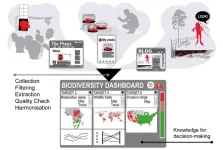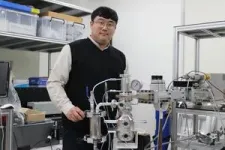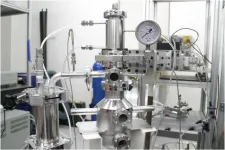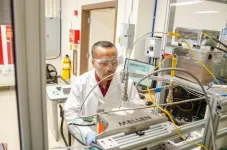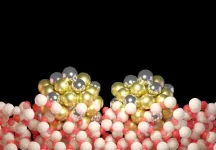(Press-News.org) The random information posted online could be used to generate information about biodiversity and its conservation.
“I think it's quite amazing that images and comments that people post online can be used to infer changes on biodiversity”, says Dr. Andrea Soriano-Redondo, the lead-author of a new article published in the journal Plos Biology and a researcher at the Helsinki Lab of Interdisciplinary Conservation Science at the University of Helsinki.
Scientists from the University of Helsinki together with colleagues from other universities and institutions around the world propose a strategy for integrating online digital data from media platforms to complement monitoring efforts to help address the global biodiversity crisis in light of the Kunming-Montreal Global Biodiversity Framework.
“Online digital data, such as social media data, can be used to strengthen existing assessments of the status and trends of biodiversity, the pressures upon it, and the conservation solutions being implemented, as well as to generate novel insights about human–nature interactions”, says Dr. Andrea Soriano-Redondo.
“The most common sources of online biodiversity data include web pages, news media, social media, image- and video-sharing platforms, and digital books and encyclopedias. These data, for example geolocated distribution data, can be filtered and processed by researchers to target specific research questions and are increasingly being used to explore ecological processes and to investigate the distribution, spatiotemporal trends, phenology, ecological interactions, or behavior of species or assemblages and their drivers of change”, she continues.
Data generated through the framework in near real-time could be continuously integrated with other independently collected biodiversity datasets and used for real-time applications.
“Data relevant to assessment of species extinction or ecosystem collapse risk, for example, could be mobilized into the workflows for generating the IUCN Red List of Threatened Species and Red List of Ecosystems”, says Dr. Thomas Brooks, chief scientist of the International Union for the Conservation of Nature and a co-author in the article.
“Other data on sites of global significance for the persistence of biodiversity could be served to the appropriate national coordination groups to strengthen their efforts in identifying Key Biodiversity Areas”, he continues.
Data on the illegal wildlife trade could also be integrated with the Convention on International Trade in Endangered Species of Wild Fauna and Flora (CITES) Trade Database or the Trade Records Analysis of Flora and Fauna in Commerce (TRAFFIC) open-source wildlife seizure and incident data.
Online digital data can also be used to explore human-nature interactions from multiple perspectives.
“We have successfully used social media data to identify instances of illegal wildlife trade. There is great potential to use these data to provide novel insights into human–nature interactions and how they shape, both positively and negatively, biodiversity conservation”, says Professor Enrico Di Minin, senior co-author in the article, from the University of Helsinki.
“The necessary technology to implement the work is available, but it will require harnessing expertise from multiple sectors and academic disciplines, as well as the collaboration of digital media companies. Most importantly we need to ensure full access to the data as to maximize its full potential to help address the global biodiversity crisis and other sustainability challenges”, he continues.
END
Online digital data and AI for monitoring biodiversity
2024-02-16
ELSE PRESS RELEASES FROM THIS DATE:
Heart attack significantly increases risk of other health conditions
2024-02-16
Having a heart attack significantly increases the risk of developing other serious long-term health conditions, a major new study shows.
Researchers at the University of Leeds have analysed more than 145 million records covering every adult patient admitted to hospital over a nine-year period to establish the risk of long-term health outcomes following a heart attack – in the largest study of its kind.
Whilst heart attacks are a serious and life-threatening condition, the British Heart Foundation estimates that nowadays more than seven in 10 people survive them, provided they receive quick and emergency treatment to get the blood flowing to the heart muscle again. Yet ...
Plasma technology for more effective lithium extraction
2024-02-16
New research suggesting a improved method for extracting lithium by applying plasma technology has been recently published.
On the 31st of January, the Korea Institute of Fusion Energy(KFE) announced revealed that their researchers have successfully increased the lithium extraction rate by three times compared to pre-existing methods by applying CO2 microwave plasma technology.
The most common method of extracting lithium is mixing sodium carbonate(Na2CO3) to saltwater that contains lithium and extracting lithium carbonate(Li2CO3)-which is a mixture of lithium and carbon dioxide. The downside to this method ...
Can astronomers use radar to spot a cataclysmic asteroid?
2024-02-16
How can humans protect the Earth from “devastating asteroid and comet impacts?” According to the National Academies and their 2023-2032 Planetary Science and Astrobiology Decadal Survey, ground based astronomical radar systems will have a “unique role” to play in planetary defense.
There is currently only one system in the world concentrating on these efforts, NASA’s Goldstone Solar System Radar, part of the Deep Space Network (DSN). However, a new instrument concept from the National Radio Astronomy Observatory ...
Self-monitoring improves physical activity of care-needing elderly
2024-02-16
Self-monitoring of physical activity with an accelerometer and feedback is an effective tool to improve physical activity in elderly people requiring long-term support. The Kobe University study is the first to show that with simple and safe means the physical activity of this demographic can be improved, which is expected to help prevent serious illness and reduce costs for long-term care.
Taking more steps and sitting less is well known as having a significant influence on a wide range of noncommunicable diseases such as heart disease, diabetes, orthopedic diseases and stroke. This is particularly problematic in senior citizens who depend on long-term care such as in day-care ...
WVU close to commercializing microwave technology that can cool down industry’s energy usage
2024-02-16
West Virginia University engineers have secured $3 million in U.S. Department of Energy funding to research a new chemical reactor system that uses microwaves to reduce industrial heat and carbon emissions.
The first-of-its-kind technology would allow industrial facilities to simultaneously produce ethylene and ammonia, two chemicals that contribute significantly to greenhouse gas emissions, within a single microwave reactor. That device uses heat from microwave electromagnetic radiation to carry out chemical reactions.
The ...
New Issue of GEN Biotechnology
2024-02-16
GEN Biotechnology announces the publication of its February 2024 issue. GEN Biotechnology publishes outstanding peer-reviewed research and perspectives in all aspects of biotechnology. The Journal, led by Editor-in-Chief Hana El-Samad, PhD (UCSF; Altos Labs) and Executive Editor Kevin Davies, PhD, is published bimonthly in print and online.
For full-text copies of articles or to arrange interviews with Dr. El-Samad, Dr. Davies, authors, or members of the editorial board, contact Kathryn Ryan at the Publisher.
1. Original Research: ...
New chip opens door to AI computing at light speed
2024-02-16
Penn Engineers have developed a new chip that uses light waves, rather than electricity, to perform the complex math essential to training AI. The chip has the potential to radically accelerate the processing speed of computers while also reducing their energy consumption.
The silicon-photonic (SiPh) chip’s design is the first to bring together Benjamin Franklin Medal Laureate and H. Nedwill Ramsey Professor Nader Engheta’s pioneering research in manipulating materials at the nanoscale to perform mathematical computations using light ...
Study shows impact of antidepressants on fetal brain development during pregnancy
2024-02-16
A new study published in Nature Communications provides direct evidence that antidepressant use during pregnancy can impact a child’s brain development and contribute to the risk of mental health disorders later in life.
The study, led by researchers at the University of Colorado Anschutz Medical Campus, focused on the effect of fluoxetine, commonly used in medications such as Prozac and Sarafem for treating depression and perinatal depression, on a developing prefrontal cortex.
Since fluoxetine works by increasing the levels of serotonin in the brain, the researchers looked at the impact serotonin has on prefrontal ...
First human trial shows ‘wonder’ material can be developed safely
2024-02-16
A revolutionary nanomaterial with huge potential to tackle multiple global challenges could be developed further without acute risk to human health, research suggests.
Carefully controlled inhalation of a specific type of graphene – the world’s thinnest, super strong and super flexible material – has no short-term adverse effects on lung or cardiovascular function, the study shows.
The first controlled exposure clinical trial in people was carried out using thin, ultra-pure ...
Towards more efficient catalysts
2024-02-16
Researchers from the Harvard John A. Paulson School of Engineering and Applied Sciences (SEAS), Harvard Department of Chemistry & Chemical Biology, and Utrecht University have reported on a previously elusive way to improve the selectivity of catalytic reactions, adding a new method of increasing the efficacy of catalysts for a potentially wide range of applications in various industries including pharmaceuticals, cosmetics and much more.
The research is published in ...
